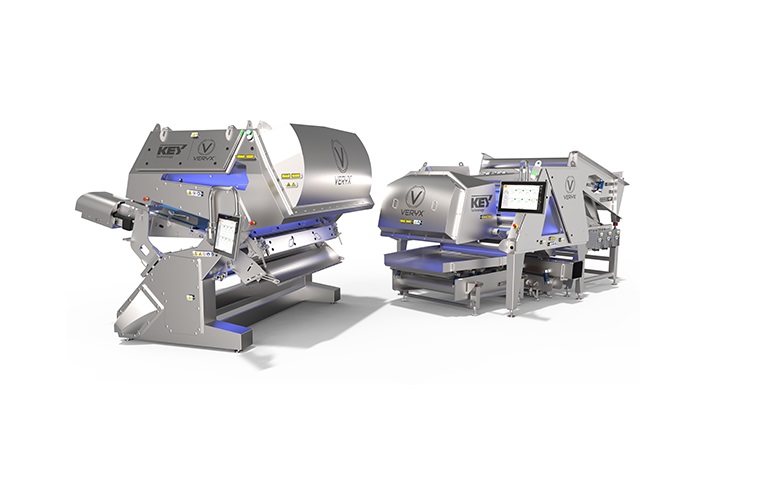Key Technology, a member of the Duravant family of operating companies, presents their most versatile Veryx belt-fed digital sorters, with specific design elements that benefit vegetable processors producing multiple products. Veryx is a belt-fed sorter that can inspect product entirely in-air with top and bottom sensors in order to detect and eliminate all foreign material (FM) and the right amount of product defects to make grade. Featuring Key’s unique recipe-driven operation, along with the ideal hardware and software to sort any number of different products, Veryx can be changed over to handle a new product in seconds. With sort recipes saved to memory for quick recall, Veryx eases use and ensures repeatable results to optimize product quality and maximize yield.
“Worldwide, many vegetable processors typically handle three or more seasonal products throughout the year to fully utilize their factories. In Europe, they might handle as many as 30 seasonal products. In these high changeover environments, processors need more production flexibility. With a multitude of successful Veryx installations, our recipe-driven operation is field proven to help customers achieve consistent sort performance so product quality is guaranteed day in and day out, regardless of personnel changes and across multiple lines and locations,” said Karel Van Velthoven, Advanced Inspection Systems Product Marketing Manager at Key. “Our expertise in vegetable sorting enables us to develop the most effective recipes. With a couple of taps on the touchscreen, an operator can retrieve a recipe saved to memory and accurately set Veryx to handle the next product.”
For processors of both canned and frozen vegetables that are sorting a variety of wet products prior to blanching, Key tailors each belt-fed Veryx with the ideal sensors, sensor positions, lighting, ejection system, product handling and software dedicated to the processor’s products and objectives. Capable of detecting color, size, shape and structural properties of every object, including the presence or absence of chlorophyll, Veryx removes insects, animal parts, paperboard, wood, rocks, plastics, glass and extraneous vegetative matter (EVM) such as weeds and other plant materials, as well as product defects. Veryx comes in different sizes to satisfy a range of production capacity requirements.
The next-generation 4‑channel cameras and laser scanners available on Veryx offer twice the resolution of previous sensor technology. Optional Pixel Fusion combines pixel-level input from multiple cameras and laser sensors to produce higher contrasts and enable the most-difficult-to-detect FM and defects to be removed without false rejects. When configured with top- and bottom-mounted sensors, Veryx achieves all-sided surface inspection to maximize FM and defect detection. By positioning bottom-mounted sensors, along with light sources and backgrounds, away from product splatter, Veryx sustains full-surface inspection throughout the longest production cycles in the most demanding environments.
Essential for all processors, especially those handling a variety of different products, Key’s expertise in both sorting and product handling enables them to design the ideal integrated system for each application. Every system is customized to effectively present product to the sorter’s inspection zone, maximizing sort accuracy, with minimal mechanical changes. Application-specific infeeds and collection shakers can serve additional functions, like dewatering and mechanically screening out FM. Optional three-way sorting enables Veryx to optically separate good product into two grades while removing FM and defective product into a reject stream.
As the most advanced sorter on the market for data collection, Veryx can leverage Key’s powerful Information Analytics software, which allows users to analyze and share big data across their enterprise via an Opcua-compliant infrastructure at the same time they sort. Data about the sort process and about each and every object flowing through the sorter, whether the data is used to make sort decisions or not, is available to reveal patterns, trends and associations. This data can help a processor better manage incoming raw materials and optimize processes upstream and downstream of the sorter to achieve the next level in operational efficiency.

















